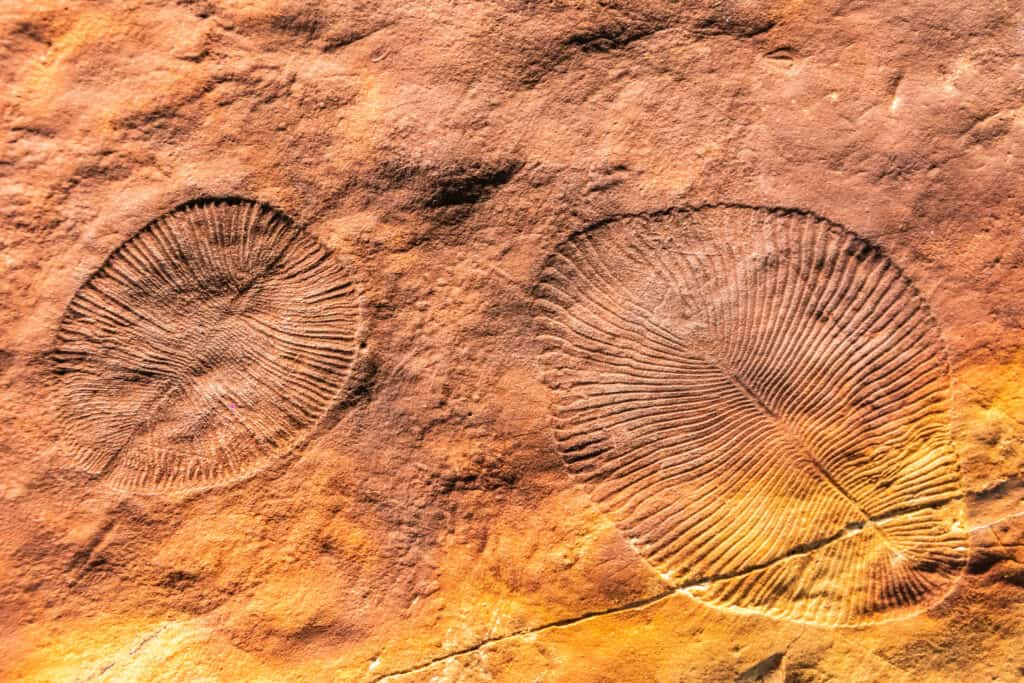Dickinsonia
Advertisement
Dickinsonia Scientific Classification
- Kingdom
- Animalia
Read our Complete Guide to Classification of Animals.
Dickinsonia Conservation Status
Dickinsonia Facts
View all of the Dickinsonia images!
Introduction
The Dickinsonia is an extinct genus of basal animal, and they lived during the Ediacaran period that lasted for 96 million years. You will find the Dickinsonia in the places we now know as China, India, Russia, Australia, and Ukraine and resembles a bilaterally symmetrical oval. The remains of this creature are in sandstone beds.
Description & Size

The first discovery of the Dickinsonia fossils was in 1947 in South Australia by Ilya Bobrovskiy a PhD student from the Australian National University.
©Alizada Studios/Shutterstock.com
The Dickinsonia did not have legs or a formed body structure; they instead had an egg-shaped body with rib-like segments. The rib segments started off narrow at the bottom and increased in width near the end of the fossil. The segments of the Dickinsonia are “pneus,” chambers full of liquid at higher ambient temperatures.
The average Dickinsonia grew up to be 4 ft 7 inches in size, but they could also reach only a few millimeters in size and width. The size records depend on the size of the fossils found.
Australian National University confirms the Dickinsonia to be neither a microbe nor plant. It is a photosynthesizing multicellular organism with a complex system. Existing 17 million years before modern animals and thought to be one of Earth’s earliest animals.
- Size: A few millimeters to 4 ft 7 inches
- Time Period: Ediacaran period
- Extinction: 539 million years ago
- Type of Animal: Photosynthesizing multicellular organism
- Location: Ukraine, Russia, Australia, China, and India.
- Fossilization: Bases of sandstone beds
Diet – What Did Dickinsonia Eat?
The Dickinsonia absorbs food from the bottom of their bodies because they are a stem-group protozoan. The Dickinsonian fossils found in the base of sandstone beds do not give paleontologists much information as to what these creatures ate. The possible food sources included algae and microbes found near water bodies.
Habitat – When and Where It lived
The Dickinsonia fossils are found embedded in the base of sandstones, throughout Australia, China, Ukraine, Russia, and India. Living during the late Ediacaran period over half a million years ago, they are thought to be the oldest records of animals.
The fossils are found were very compressed and distorted sometimes into the underlying rock. The preservation of the fossils shows that the Dickinsonia tried to escape from the sediment.
According to Retallack’s hypothesis in 2007, the Dickinsonia is believed to move slowly from one resting place to the other by firmly anchoring their bodies into the sediment. Their anchoring movements could have been from their lichen-like rooting through rhizines, or perhaps a fungus-like attachment to a network of underground hyphae.
Threats And Predators
The Dickinsonia has no known threats or predators, they most likely faced extinction at the end of the Ediacaran period.
Discoveries and Fossils
The first discovery of the Dickinsonia fossils was in 1947 in South Australia by Ilya Bobrovskiy a PhD student from the Australian National University. They are found in China, India, Russia, and Ukraine and were around 570 million years old. Each fossil was pancake-shaped and well-preserved fossils in the northwestern Russian cliff still contained organic matter.
Dickinsonia fossils have been found in the following locations:
- South Australia
- Dniester River Basin of Podolia, Ukraine
- Bhimbetka rock shelters in India
- Chernokamen Formation of the Central Urals, Russia
- Dengying Formation in the Yangtze Gorges in South China
- White Sea area of the Arkhangelsk
- Madhya Pradesh in India
Extinction – When Did It Die Out?
The Dickinsonia lived during the late Ediacaran period and likely went extinct after this period when the earth’s oceans went completely anoxic proposed by researchers. The Ediacaran period was a geological period lasting 96 million years from the end of the Cryogenian period to the beginning of the Cambrian period.
The samples recovered from the last 10 million years of the Ediacaran period found extreme anoxia which lined up with the disappearance of the Ediacaran biota. Extreme anoxia is when the ocean had total oxygen depletion, resulting in mass extinctions.
Similar Animals to The Dickinsonia
The Dickinsonia has been described as a type of polychaete worm, turbellarian, sea anemone, lichen, or even coral and jellyfish. There are some similar genera to the Dickinsonia that could be related.
Similar fossils to the Dickinsonia include:
- Yorgia– A discoid Ediacaran organism that had no appendages and a maximum length of 9.8 inches.
- Marywadea- Ediacaran biota with an oval body shape that resembles a primitive trilobite.
Dickinsonia FAQs (Frequently Asked Questions)
When was the Dickinsonia alive?
The Dickinsonia lived during the Ediacaran period around 558 million years ago in the Phanerozoic Era.
How big was the Dickinsonia?
The Dickinsonia fossils ranged in size from a few millimeters to 4 ft and 7 inches. They most likely continued to slowly grow until death.
Thank you for reading! Have some feedback for us? Contact the AZ Animals editorial team.
Sources
- Info galactic , Available here: https://infogalactic.com/info/Dickinsonia
- Wikipedia , Available here: https://en.wikipedia.org/wiki/Dickinsonia
- Earths Archives , Available here: https://eartharchives.org/articles/dickinsonia-is-an-animal/index.html

















